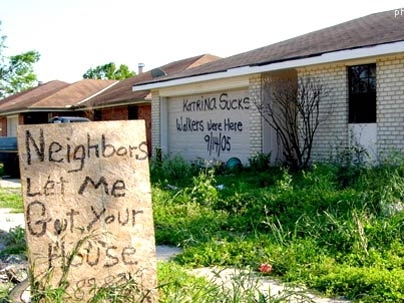Graduate student Leigh Graham of MIT's Department of Urban Studies and Planning (DUSP) has been commuting between New Orleans and Boston since last September, working with others from DUSP on a number of projects in the hurricane-ravaged city.
A native of Dorchester, Mass., Graham, 31, felt a passion for helping the disenfranchised that was fostered at a young age. Following the terrorist strikes of Sept. 11, 2001, she spent three years at a New York nonprofit, working on such projects as a small business recovery program for Lower Manhattan firms affected by the attacks.
Graham recently described her experiences in New Orleans for the MIT News Office.
Q: What made you decide to go to New Orleans?
A: When I watched the aftermath of Katrina unfold on TV in the five or so days after August 29th, 2005, I was sick. I found it incredibly upsetting to watch the anger, suffering, panic and chaos.
My academic work at MIT is fundamentally about poverty alleviation and equity -- especially for the poor, African-Americans, and other disenfranchised groups in the U.S. Personally, I am the first of three generations in my family to move out of Dorchester, Mass. My parents grew up in public housing around Boston.
The challenges that affect the working and truly poor in the U.S. are not foreign for certain family members.
Q: What is your work with Project Home Again?
A: In February, I went with Phil (Associate Professor J. Phillip Thompson of DUSP) to a meeting with the AFL-CIO's Building and Construction Trades Department about their proposal to fund a workforce development program in New Orleans. Given our experience in New Orleans so far, this led to an ongoing collaboration with the AFL-CIO to bring their proposed Gulf Coast Initiative -- Back Home in New Orleans -- to the ground. We were instrumental in guiding them to their pilot site in Trem̩. We are working with them on designing an organizing and planning process around the redevelopment of 197 parcels and now Lafitte.
Q: What challenges have arisen in your work in New Orleans?
A: It's the most complex political environment I've ever been in, and the racial dynamic of it is omnipresent. Phil and I have been commuting. This makes getting anything done more difficult than it needs to be. The degree of politics makes it psychologically challenging. It is really hard to keep switching gears between the all-consuming complexity and emotion of life down there with being back up in Boston.
I've been incredibly exhausted from the last nine months. The city has virtually no resources -- human capital, financial, etc. -- to set its own course for recovery and redevelopment. It reminds me more of Tanzania with the lack of resources and the politics (not to mention the weather) than any place I've worked in the U.S. I am neither the first nor the last person to compare New Orleans to a developing country, that's for sure.
Q: How are the people of New Orleans approaching rebuilding?
A: Overall, there's a profound sense of grief and loss in the city that I also experienced after 9/11; when people slowly realize that no matter what their best efforts, a world they knew is irrevocably gone, and every effort is nonetheless toward, at best, re-creating it or, at worst, building something new from scratch -- even if that's eventually for the better.
But the poverty and politics of the place make it feel pretty unlikely that most New Orleanians will be able to reclaim anything close to what they've lost, and that's a pretty hard pill to swallow.
Q: What more do you think could be done?
A: I wish that more was being done at the federal, state, municipal and grassroots organizing level to help those permanently relocated to new places around the U.S. rebuild their lives with some dignity and opportunity that they otherwise lacked in relatively poor, service-sector-dependent New Orleans.
I wish the U.S. had better policies to address displacement following disasters, including relocation in redevelopment, when appropriate. This is an area I work on in some of my academic research, but I am not doing much else about it at ther point in my practice.
Q: What more do you think MIT could do?
A: I'd like MIT as an institution to have a long-term, formal presence there. I'd like to find a long-term local partner down there through which MIT could place students, practitioners, scholars and others on the ground to provide expertise, input, conduct projects and research, and generally contribute to the recovery and sustainable existence of the city.
DUSP works long-term in Beijing and Springfield, Mass., among other places. I'd like New Orleans to be added to that roster, but at an institution-wide level, and I'd like to help funnel students and projects down there.
Q: What do you envision for your future?
A: I plan to continue this commute through the end of 2006 and then relocate to New Orleans full time in 2007, for at least the next 12-18 months.
I don't know what I'll do when I finish my Ph.D., if I'll teach or do research elsewhere, or return to practice. I will need a career in which I can conduct fieldwork, preferably in complex, maybe even crisis-oriented settings. This is how I'll apply myself to my "vision" for New Orleans, or more importantly, to New Orleanians' "vision(s)" of the city. I am committed to the city and its future, and will work there for as long as I can psychologically hack it.







